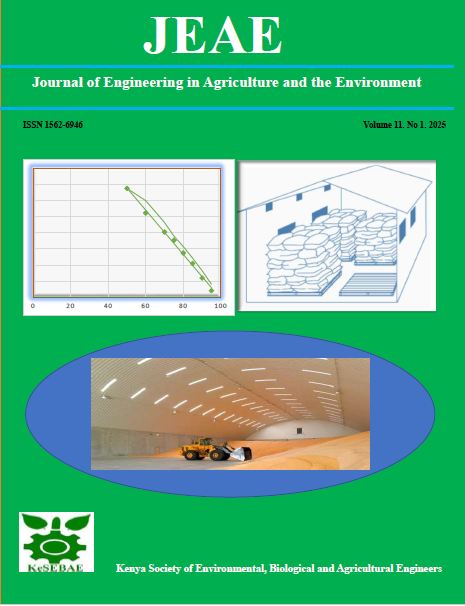Abstract
Most developing countries have much of their population cooking using unclean fuels. The use of dirty fuels in households results to Indoor Air Pollution (IAP) with negative impacts on human health. Increased use of firewood and charcoal results to degraded forest cover. However, most Countries have committed to promote clean cooking in line with the requirement of SDG7 and the Paris agreement of COP21. Ethanol has been identified and promoted as one of the cleanest fuels for cooking either as a gel or liquid of varying ethanol concentration. When processed from biomass, ethanol then referred to as bioethanol is seen to offer an affordable clean option for transitioning households to clean cooking. This study was to determine the optimal ethanol concentration in ethanol cooking fuel. Fuel samples of different ethanol concentration ranging from 50% to 95% at intervals of 5% were prepared from a 95% (190proof) ethanol fuel by mixing with distilled water and tested for fuel properties by conducting the Water Boiling Test. From experiments done, the lowest concentration that achieved boiling was 75%. The Fuel consumed, Specific Fuel Consumption, Time to Boil, Fire Power and Burning rate were found to be dependent on ethanol concentration and there was significant variation across the various concentrations. Thermal efficiency was not dependent on ethanol concentration and there was no trend observed across the various concentrations. Post Hoc comparison within groups indicated no significant difference in performance of the 90% and 95% ethanol concentration fuel samples. Given the corresponding energy demand and related cost of refining ethanol from 90% to 95% concentration, it was concluded that 90% ethanol concentration is the optimal concentration for ethanol cooking fuel while using a liquid ethanol stove with a fiber filled canister.
References
Adamu Shanono, I. D. (2020). Performance and emissions of liquid biofuel cooking stoves. Journal of Technology and Engineering, 7, 219-238.
Alliance, C. C. (2014). The Water Boiling Test (Version 4.2.3). CCA.
Approvecho Research Center. (2009). Results of testing of the cleancook stoves for fuel use and carbon emissions.
Bacovsky, D., Matschegg, D., Janssen, R., Rutz, D., & Costanzo, B. D. (2022). Unlocking the bioethanol economy: A pathway to inclusive and sustainable industrial development in developing countries. UNIDO.
Dalberg. (2020). Kenya ethanol cooking fuel masterplan . Dalberg.
Dana K Armstrong, M. K. (2023). Econimic and social feasibility pilot in ethanol fuel for clean cooking in Sierra Leone. Development in Practice 2023, 6-29.
Doris Matshegg, D. B. (2022). Unlocking the bioethanol economy: A pathway to inclusive and sustainable industrial development in developing countries. UNIDO.
Elisa, P., & Daniel Pope. (2017). Clean fuels for cooking in developing countries. Encyclopedia of sustainable technologies, 289-297.
Hajamala, A. M. (2014). Thermal performance of a low concentration ethanol stove without pressure system. Research Communications.
I.J Dioha, C. N. (2012). Comparative studies of Ethanol and Kerosene fuels and Cookstoves performances. Journal of Natural Resources Research, Vol 6.
Kenya Bureau of Standards. (2021). Denatured Technical Alcohol for use as cooking and appliances fuel - Specification. KEBS.
Magdalena, J. A., Greses, S., & Fernandes, C. G. (2021). Valorisation of bioethanol production residues through anaerobic digestion: Methane production and microbial communities. Science of the total environment.
Makonese, T., Annegarn, H. J., & meyer, J. (2020). Performance evaluation of three methanol stovesusing a contextualtesting approach. Energy for sustainable development, 13 -23.
Megan L. Benka-Cocker, W. T. (2018). A case study of the ethanol cleancook stove intervention and potential scale up in Ethiopia. Energy for sustainable development.
Ministry for Energy and Petroleum. (2015). Sustainable Energy FOr All - Kenya ACtion Agenda. Ministry of Energy and Petroleum.
Ministry of Energy. (2020). Bioenergy Strategy 2020 - 2027. Ministry of Energy.
Muthukumar Palanisamy, L. K. (2023). Evolutions in Gaseous and Liquid Fuel Cookstove Technologies. Energies 2023.
Muyiwa Okusanya, O. C. (2019). Development and performance evaluation of an ethanol gel cookstove. International Journal of Engineering Science invention.
Organization, W. H. (2019). Household Air Pollution and Health. WHO.
Peter O. Oketch, H. M. (2014). Experimental study of fuel efficiency and emissions comparison from bioethanol gel stoves. Proceedings of 2014 International conference on Sustainable Research and Innovation. Jomo Kenyatta University of Agriculture and Technology.
Peter O. Oketch, H. M. (2014). Experimental study of fuel efficiency nd emissions comparison from bioethanol gel stoves. Proceedings of 2014 International Conference on Sustainable Research and Innovation,, 5.
Timothy J.Tse, D. J. (2021). Production of bioethanol - A review of tactors affecting ethanol yield. open access.
Vane L.M, A. F. (2013). Experimental validation of Hybrid distiilation - Vapor permeation process for energy efficient ethanol-water sepertion. Chemical Technology and Biotechnology, 1677-1682.
World Health organisation . (2021). WHO Global air quality guidelines. WHO.
World Health Organisation. (2014). WHO guidelines for indoor air quality: Household fuel combustion. WHO.

This work is licensed under a Creative Commons Attribution 4.0 International License.
Copyright (c) 2025 Lucy Wangai, Joseph Muguthu, Eliud Njagi, George Momanyi
